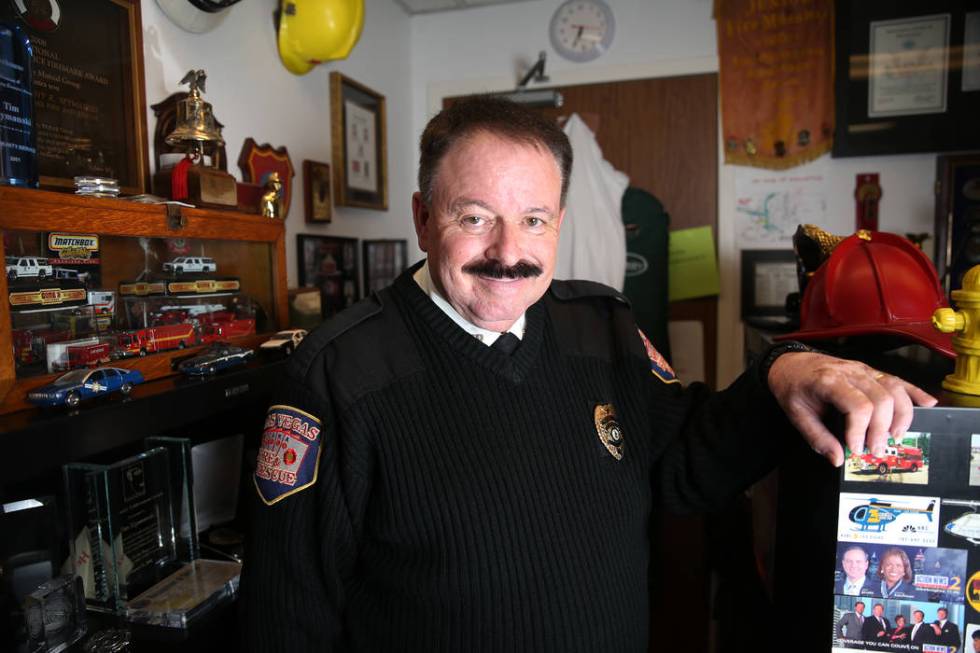Las Vegas Fire and Rescue’s Tim Szymanski has seen many changes

Vegas Voices is a weekly series highlighting notable Las Vegans.
Tim Szymanski was taking college courses in law enforcement when the native of suburban Cleveland joined the fire service in nearby Northfield Center in 1970.
It sparked a career that is now nearing a half-century, including the past 23 years as the public face of Las Vegas Fire and Rescue.
A member of Ohio’s first paramedic class in 1973, Szymanski stayed in the Cleveland area until 1978, when he and his wife, Ellen, and 1-year-old son, Steven, followed Szymanski’s mother to the Atlanta area.
He moved up through the ranks with the fire department in Gwinnett County, Georgia, and in 1981 was asked to spend 30 days with a new chief from out of town, familiarizing him with the area. When the month was up, the chief put Szymanski in charge of the fledgling field of media relations.
“Back then, the fire and the police didn’t get along with the media,” Szymanski says. “I was flying by the seat of my pants.”
He wrote for help from public information officers in Los Angeles and Phoenix and honed his craft as other departments in the area made similar appointments.
But six years later his career took a detour, as Szymanski became the first full-time fire chief in Winder, Georgia. The family, which now included son Christopher, settled into a 100-year-old home there that remains Szymanski’s favorite. The job, not so much.
“Every firefighter wants to be chief,” he says. “I just didn’t care for it.”
In 1992, the former Gwinnett chief, who’d been named fire chief for the upcoming Olympics in Atlanta, asked Szymanski to serve as public safety planner for the games, which would include handling public information. He worked with people from multiple agencies, all over the world. “It was an education you just can’t get,” Szymanski says.
Then in April 1996, the chief, who was supposed to speak to a member of the National Association of Fire Chiefs, had a conflict and asked Szymanski to take his place. In the audience was Clell West, chief of the Las Vegas fire department. West was set to retire and had promised the administration he’d hire his first public information officer, since the one from the county was getting all the press.
In May, the call came: Would Szymanski like to come to Las Vegas? He hung up, thinking his co-workers were playing a joke. They called back. He and Ellen made their first trip to Las Vegas, and later that month he had an official offer and a query as to how soon he could move west.
“I said I’d been working on the Olympics for four years, and it was in two months,” Szymanski says. They gave him until two weeks after the closing ceremonies.
Szymanski, 67, has expanded that original role and now is public education and information officer for Las Vegas Fire and Rescue. He’s been in fire service for 49 years and figures maybe he’ll retire in six years or so — “I take care of myself,” he says.
He recently sat down to talk about his job, fire safety and career accomplishments.
Review-Journal: How safe are Las Vegans from fire?
Tim Szymanski: This is probably the best fire safety city in the world. Because of the (1980) MGM Grand fire, hotels put sprinklers in. They had a hotel safety program when I came here; they were very progressive. Because of 1 October, we now have rescue plans. And in the big resorts, we don’t have to drag hoses and things like that. There’s all kinds of systems. Because the resorts are little cities, they have safety systems built in. In Atlanta, we had really big fires in really old buildings. We had a warehouse fire that took three days to put out.
How do the various jurisdictions work together?
We have a well-oiled machine here in the valley. We had an Incident Control System in use long before it was mandated on a federal level; they were doing it well before I got here. We have automatic aid. Here, there are no lines (between jurisdictions). In the 911 center, that computer doesn’t know there are different departments. It’s all interchangeable. The computer sends the nearest help. I’ve never seen it work better than it does in Las Vegas.
How have people changed since you got started?
People are bigger now. It used to be, a person who weighed 150 pounds was heavy. All of our cots are motorized now.
What about equipment?
I remember when we introduced the Jaws of Life. We were using tow trucks to pull cars apart. It was kind of medieval. The main tools of the trade used to be a pager, a Handie-Talkie (two-way radio) and a roll of quarters (for public phones). Electronics have changed so much. I can’t believe how much it’s changed just over the past several years. And social media. I use Twitter a lot; we have pictures as it’s going on. The media and officials follow it.
What are you most proud of?
Since I’ve been here, I wrote two history books on Las Vegas Fire and Rescue. One of the things I want our guys to remember is their roots. (Szymanski learned that the first Las Vegas firefighter killed in the line of duty — Harold Davenport, who was 34 — died because of a cat, which he was attempting to rescue from atop a utility pole. He lost his grip on the cat, which scratched him, and Davenport touched a live power line. Szymanski also created a poster to honor firefighters killed in the line of duty.) The books and the Citizens Fire Academy are my proudest accomplishments.
Contact Heidi Knapp Rinella at hrinella@reviewjournal.com or 702-383-0474. Follow @HKRinella on Twitter.